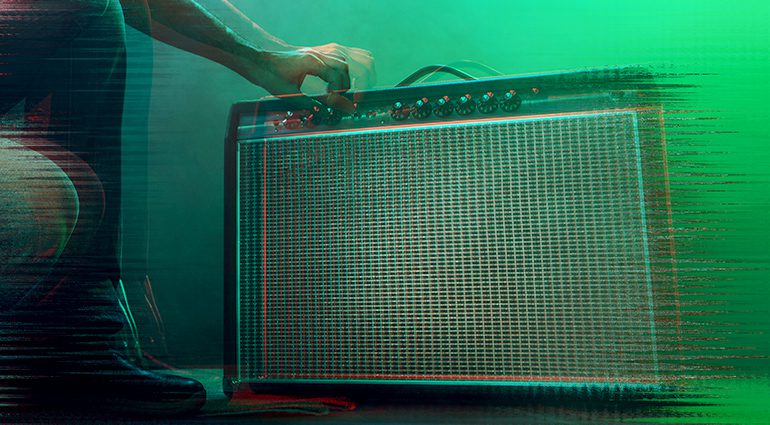
Sometimes, things go wrong, and your amp hums or hisses instead of producing a powerful guitar sound. Although the causes can vary, the problem is sometimes quite easy to fix. We’ll show you a few things to check if your amp is humming or hissing.
Humming, hissing, crackling: What does the noise sound like?
Different types of noise can occur in an amplifier. In order to troubleshoot the problem, it is important to clearly identify the noise. Humming is a low-frequency noise that’s usually continuous. It often sounds the same as the noise that occurs when you touch the socket with the tip of the plug while plugging the cable into the guitar while the amp is switched on.
Hissing is noise in a much higher frequency range, similar to the sound of waves washing up on a beach. This type of noise is also usually permanent. Crackling noises, on the other hand, occur at irregular intervals and also tend to be in a somewhat higher frequency range. To find the right solution, you should be able to distinguish between these three sounds.
The amp is humming: The cable could be broken or not plugged in correctly
The simplest cause of a humming noise is a cable that isn’t plugged in correctly. Before taking any other action, check whether all cables on your pedalboard, the guitar, and your amp are connected correctly. If the hum persists, a defective cable could be the problem.
In this case, searching for the culprit becomes a little more complicated, because you need to check every cable in the signal path. A cable tester can be very helpful for this, as it lets you check quickly whether a cable is intact or needs to be replaced.
The amp is humming: Ground loop
If the cables are OK, a ground loop could also be causing the problem. This occurs when the signal ground is earthed in two or more places. For example, it can happen if you use a pedalboard with mains-powered effects or run a setup with multiple amps.
To prevent ground loops, you should connect all your guitar gear to a single mains outlet using a power strip. Do not use two different outlets for the amp and the pedalboard. However, this doesn’t work in all cases. Sometimes, a ground loop is created anyway. Luckily, there are useful helpers that prevent ground loops when inserted into the signal path (e.g. before the amp input). In many cases, the humming noise is then immediately eliminated.
The amp is humming and causing feedback: Defective tube
If the tubes have a high number of operating hours under their belt, some amps can generate strong feedback. This usually occurs when you stop playing. Later on, it can also lead to a strong hum, before the tube eventually gives up completely and the amp no longer makes any sound. The logical solution is to replace the tube. It may be necessary to have this done by a specialist, as power amp tubes should be calibrated by an expert.
The amp is humming: Interference from single coil pickups
Single coil pickups can also be the cause of humming noises generated by electromagnetic interference, which usually results from alternating currents. The sources can be transformers in power supplies, stage lighting dimmers, neon lights, or even computers. You can easily check for interference in single coil pickups by selecting a combination of two pickups using the pickup selector switch on your guitar.
If the noise is now gone, then the single coil pickup that makes noise when selected individually is the culprit. This problem can occur in many situations on stage, and the only quick remedy is to move to another position where the noise is less noticeable. The closer you are to a source of interference, the louder the noise. If you often play in locations where interference is a problem, then you could consider replacing the pickups. For example, Fender offers noiseless single coils that are better suited to such situations.
The amp is humming: Wah pedal interference
The wah pedal is a weak link on the pedalboard when it comes to noise. Like single coils, many wah pedals are susceptible to interference from transformers. To make matters worse, you probably have a power supply on your pedalboard, which likely includes a transformer. If this power supply is placed too close to the wah pedal, interference can occur, which then causes humming and noise when the wah is switched on.
When setting up your board, make sure not to place the power supply directly adjacent to or underneath the wah pedal. And while we’re on the subject of pedals: Fuzz pedals can also be fussy with power and sometimes even pick up long wave radio stations. This is why the same rules apply to them as to wah pedals.
The amp makes crackling noises: Dirty pots
If you hear a crackling noise while turning a knob on the amp, this is an indication that the sliding track of the potentiometer is worn, resulting in the contact surfaces no longer making reliable contact with each other. This is referred to as dirty or scratchy pots.
The potentiometer should either be cleaned or, if the noise persists after cleaning, replaced. The cleaning agent should be applied in small amounts and you should always consult a specialist to replace a potentiometer.
The amp is hissing: High-gain effects and inherent noise
Another phenomenon is a strong hissing noise coming from your amp. Every amp produces a certain amount of inherent noise, which of course becomes much more audible at higher volumes and higher gain settings with distorted sounds. If a compressor, booster, overdrive, or distortion effect is then added into the mix, this can drastically increase the noise level.
All of these pedals can amplify the signal, which also raises the level of background noise. In addition, the pedals often add their own inherent noise. There is no easy fix, as higher distortion levels always lead to increased noise.
You can use a noise gate to silence your guitar when you’re not playing. This helps enormously, as the noise usually isn’t that noticeable while playing.
Conclusion: Hum and noise from the amp
If your amp sounds strange, this doesn’t automatically mean that it’s broken and that you and your wallet are in for a major repair. The important thing is that you can identify the type of noise and then start troubleshooting accordingly. We hope that this article helps you keep amp noises under control.
Feedback: Hum and noise from the amp
How do you deal with noise coming from your amp? Let us know in a comment.
You are currently viewing a placeholder content from Facebook. To access the actual content, click the button below. Please note that doing so will share data with third-party providers.
More InformationYou are currently viewing a placeholder content from Instagram. To access the actual content, click the button below. Please note that doing so will share data with third-party providers.
More InformationYou are currently viewing a placeholder content from X. To access the actual content, click the button below. Please note that doing so will share data with third-party providers.
More Information













